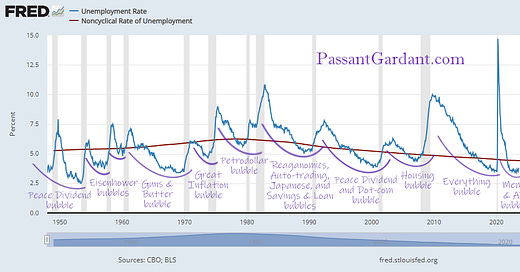Low unemployment, while generally viewed as a positive economic indicator, always signals a coming recession. This paradoxical situation can be explained by several interrelated economic dynamics.
Unemployment rates below the noncyclical or “natural” rate of unemployment nearly always coincide with an overheated labor market associated with a financial bubble. Under bubble conditions, money is “easy”, or readily available from the banking system and central bank. As companies use this easy money to invest in growth, they compete to hire a limited pool of available talent. This tends to raise wages to attract and retain employees. This wage growth, while beneficial to workers (and therefore consumers and spending), also leads to higher production costs for the businesses, resulting in margin contraction. Moreover, when the labor market is tight, it becomes increasingly difficult for companies to find skilled workers, which results in reduced productivity and poor long-term growth prospects.
Attempts by businesses to pass on their higher production costs to consumers raises the rate of price inflation and this triggers the central bank to raise interest rates to “cool down” the economy. Higher interest rates leads to increased borrowing costs for businesses and consumers, diminished investment, more savings, and reduced consumer spending. These factors reduce demand for goods and services, forcing businesses to lose pricing power and face losses. Therefore, they have to reduce hiring, pause on raises, and eventually trim their work force.
However, there’s always a lag in the unemployment picture vis-à-vis overall economic conditions and inflation. The central bank tightens too long into a bubble because the effects of its policies on profit margins and employment take time to evince themselves. By the time companies start laying off workers (which they’ve fought hard to secure), they’ve already suffered compressed margins and losses for months or years. Therefore, the volatility and uptick in unemployment at the end of a bubble always follows a structural economic failure already long in effect. The broad realization and recognition of this underlying defect usually causes a sudden shock in the financial markets which results in vastly tighter lending standards, bankruptcies, and mass layoffs.
Low unemployment on its own does not necessarily indicate an imminent recession, as unemployment can remain below the natural rate for some time, but it does signal impending panic when accompanied by high price inflation, structural labor market issues, declining production, and an uptick in unemployment from very low levels. These are all signs that economic and financial stability have already been undermined and that recession has already started or will be declared imminently. When this happens, expect the unemployment rate to rapidly increase to well above the natural rate for a period of up to several years.
The Federal Reserve's Beige Book report, released yesterday, said that businesses struggled during August to pass on costs to consumers, as costs of making goods are growing faster than prices. In other words, producer inflation is still raging, but consumers are tapped out and unable to pay higher prices. Last week it was reported that U.S. manufacturing contracted for a 10th straight month in August. Also released this week, Factory orders decreased $12.7 billion (2.1%) in July, worse than the market expectation for a decrease of 0.1%. Job openings are falling precipitously. Credit card delinquencies are at record highs. The Conference Board said last week its consumer confidence index tumbled to 106.1 in August, a recessionary level. The CEO of Campbell Soup recently told Yahoo! Finance that consumers are trading down from higher priced single-serving foods to bulk, stretchable meals. Clearly consumers are severely reducing spending, businesses are feeling pinched and reducing manufacturing, and fewer jobs are being posted. Moreover, the unemployment rate jumped 0.3 percentage points to 3.8% in August, the highest level since February 2022. These are all hallmarks that the economy is structurally broken and on the verge of a recessionary financial shock, just like what has happened numerous times before.
In two weeks at their FOMC meeting, the Fed will have to decide whether they should hike interest rates again and make it even harder for businesses and consumers to service their massive debts or pause/cut interest rates and acquiesce their inflation fight even though core PCE is more than double their target rate and rising. Either way, it’s probably the wrong answer. The policy mistake was made when they allowed unemployment to dip below the natural rate and now no matter what they do, the pendulum has to swing the other way.




